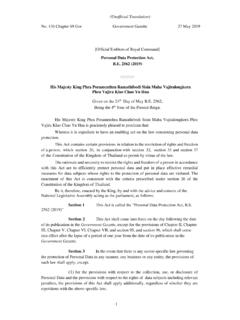Transcription of Timeline of conscription (mandatory military enlistment ...
1 Of conscription (mandatory military enlistment ) in the Colonial Period 1600s, 1700s- Each colony forms a militia made up of all adult male War (1775 - 1783)- A regular army is raised by offering enlisted men cashbonuses and a promise of free western land after the war is over. When this system does notattract enough soldiers, General George Washington calls on state militias. However these localarmies are made up of poorly trained citizens who often have to return home to tend to theirfarms. Once he becomes president, Washington tries to register all men for service. Congressdoes not pass his legislation or others proposed by Presidents Adams, Jefferson, and Madison. War of 1812 -Recruitment efforts include thirteen-month enlistment periods, a sixteen-dollarsign-up bonus and the promise of three months' pay and one hundred sixty acres of land afterservice.
2 The Congress authorizes President James Monroe to call up one hundred thousand statemilitia. Some states refuse. Mexican War (1846 - 1848) - The one-year enlistment of many troops expires. military actionmust wait until replacement troops arrive. Civil War (1861 - 1865) - The Confederate Army enlists volunteer troops for one-year periodswhile troops for the North enlist for periods of three or nine months. Eventually, each side turnsto conscription as a means of keeping its armies in place after enlistment periods end. North - In March 1863, Congress gives President Lincoln the authority to require draftregistration by all able-bodied men between the ages of 20 and 45, regardless of theirmarital status or profession. Substitute soldiers are permitted to be hired and for $ northern businessmen resist service and the Governor of New York, HoratioSeymour, declares the conscription act July 13, 1863, an angry mob sets off the four-day New York City Draft Riots byseizing the 2nd Avenue Armory and interrupting the selection of registrants' ' homes, conscription offices and city buildings are burned, shops are looted,and blacks, along with anyone refusing to join the protest, are tortured.
3 About onethousand people die. New York troops are called back from Gettysburg to quell the riotand Gov. Seymour finally urges compliance with the - The Confederacy passes their conscription law in April 1862. Three years ofmilitary service is required from all white men between the ages of 18 and 35. Substitutesare hired, resulting in poor morale and insufficient numbers of troops. Later, the age extended to include men between 17 and 50, and in 1865 the Confederate Army beginsto conscript slaves. 1898 (Spanish-American War) - Congress declares that all males between 18 and 45 aresubject to military duty. May 1917 - Congress passes the Selective Service Act, establishing local, district, state, andterritorial civilian boards to register men between the ages of 21 and 30 for service in World WarOne. There is much opposition.
4 During the first drawing, 50,000 men apply for exemptions andover 250,000 fail to register at all. In one round-up held in New York City in 1918 to catch thosewho failed to report, 16,000 men are arrested. After the war ends, efforts to set up standardmilitary training and service are defeated in Congress. 1920 - The National Defense Act establishes a system of voluntary recruitment. 1940 - Congress enacts the Selective Training and Service Act. All males between the ages of 21and 35 are ordered to register for the draft and the first national lottery is held. As World War IIprogresses, the draft age is lowered to 18 and men are called to service not by lottery number butby age, with the oldest going first. 1941 - Following the attack on Pearl Harbor, Congress gives the president power to send drafteesanywhere in the world, removing the distinctions between draftees, regulars, NationalGuardsmen and Reservists, and creating one army made up of all.
5 1947 - President Harry S. Truman recommends to Congress that the 1940 Selective Training andService Act expire and that the level of required military forces be maintained by means ofvoluntary - The level of military forces falls below necessary numbers just as the Cold War heats Truman asks that the draft be reinstated. The new Selective Service Act provides forthe drafting of men between 19 and 26 for twelve months of active service. 1950 - The Korean War draft calls up men between the ages of eighteen-and-a-half and 35 forterms of duty averaging two years. Men who served in World War II do not have to sign - The Universal military Training and Service Act is passed, requiring males between 18and 26 to register. 1952 - Congress enacts the Reserve Forces Act, compelling every man who is drafted or enlistedto an eight-year obligation to military service.
6 After a term of active duty is completed, one isassigned to standby reserve and can be called back to active duty upon a declaration of war ornational emergency. 1965 - Opposition to the war in Vietnam leads to protests against the draft. For the first timesince the Civil War, there are anti-draft demonstrations, particularly on college campuses and centers. In its v. Seeger decision, the Supreme Court broadens the definition ofconscientious objection to include religious beliefs outside the Christian, Jewish or - In response to anti-war sentiment, President Lyndon Johnson appoints a special studycommission to recommend changes in the Selective Service structure. 1967-70 - Thousands of young men either destroy their draft cards or leave the country to avoidthe draft. 1969 - President Nixon orders the "19-year-old draft": if a young man is not drafted at age 19, hewill be exempt from future military service except in the event of war or national are allowed for hardship cases, certain occupations, conscientious objectors,clergymen, and high school and college students.
7 One year later Nixon will argue in favor ofending student deferments. 1969 - President Nixon orders a "random selection" lottery system for selecting men to serve inthe war in Vietnam, changing the previous system of drafting according to age. 1970 - In v. Welsh, the Supreme Court adds sincerely held ethical and moral beliefs to thedefinition of allowable grounds for conscientious draft - The 1967 Selective Service Act, extended through an act of Congress in 1971, expires,ending the authority to induct draft registrants. 1980 - The Selective Service System becomes active - The currently operates under an all-volunteer armed forces policy. All malecitizens between the ages of 18 and 26 are required to register for the draft and are liable fortraining and service until the age of 35. 2001 MacNeil/Lehrer Productions















